ASUS F2A85-V Pro Review: A Look at FM2 with A85X
by Ian Cutress on October 10, 2012 11:20 AM EST- Posted in
- Motherboards
- Asus
- Trinity
- FM2
- A85X
3D Movement Algorithm Test
The algorithms in 3DPM employ both uniform random number generation or normal distribution random number generation, and vary in various amounts of trigonometric operations, conditional statements, generation and rejection, fused operations, etc. The benchmark runs through six algorithms for a specified number of particles and steps, and calculates the speed of each algorithm, then sums them all for a final score. This is an example of a real world situation that a computational scientist may find themselves in, rather than a pure synthetic benchmark. The benchmark is also parallel between particles simulated, and we test the single thread performance as well as the multi-threaded performance.
It should be noted that this benchmark is a purely floating point benchmark, indicative of a lot of research written code where several months of optimization is not possible or not common knowledge within the research group. The compiler is not clever enough to convert what is expected into appropriate integer conversions, so Bulldozer and Piledriver based processors will only perform as well as their singular FPU units per module will allow. The benchmark is unaffected by memory speed as thread creation is created on the CPU and all data created fits well within the L2 cache per core.
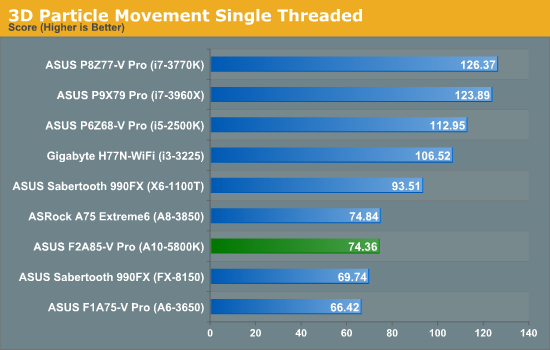
In the single threaded test, a lot of conclusions can be drawn from the comparison of AMD architectures. Direct comparison of Piledriver to Bulldozer (A10-5800K to FX-8150) gives a boost in single core performance of 7%, however comparing the old Stars cores of the A8-3850 at 2.9 GHz is roughly the same as the new Piledriver core at 4.2 GHz. So even with a 1.3 GHz advantage, Piledriver is only as good as Stars and less efficient in floating point results. If we compare Piledriver to Thuban, i.e. A10-5800K to X6 1100T, the Piledriver core gets stomped on by a good 25% performance. I find this quite staggering – most of the code I ever encountered as a computational chemist was floating point based, dealing with single and double precision on a regular basis. On this result, I would steer clear of Piledriver.

The multithreaded version of 3DPM is slightly tougher to analyze. Due to the FP nature of the program, the A10-5800K is essentially a 2 core FPU processor, whereas all the other comparative AMD processors have either 4 or 6 FPUs to play with. What is perhaps worth considering is that the Bulldozer processor with 4 modules scores 326.32, whereas the Piledriver processor with only 2 modules scores 203.06, which is more than half. This would mean that the Piledriver core actually achieves 20% better performance at the same frequency, despite our ST test giving Piledriver only a 7% increase. Part of this could be put down to the architecture improvements – improved scheduling for heavily threaded loads, one of the downfalls of Bulldozer but was improved in Piledriver could be the reason here.
WinRAR x64 3.93 - link
With 64-bit WinRAR, we compress the set of files used in the USB speed tests. WinRAR x64 3.93 attempts to use multithreading when possible, and provides as a good test for when a system has variable threaded load. If a system has multiple speeds to invoke at different loading, the switching between those speeds will determine how well the system will do. WinRAR is also very sensitive to memory speeds and subtimings.
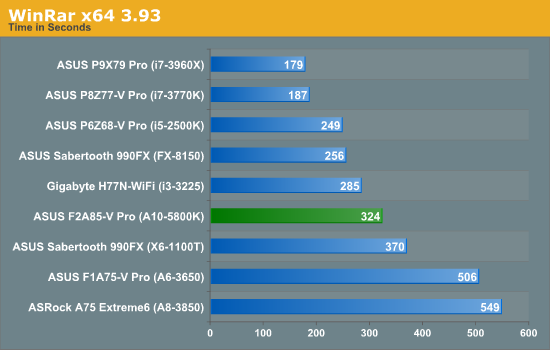
Analyzing the WinRAR results can be a little confusing, given that at different points of our previous testing the memory settings have been different (should point out that they have been consistent when comparing against like-for-like). When the A10-5800K was playing ball with DDR3-2400 10-12-12 memory, the WinRAR copy test pulled out miles ahead of the Thuban and Llano processors by a good margin. However the Sandy Bridge i5-2500K, with 4 INT and 4 FPU units gave the Trinity processor a proverbial thrashing despite being limited to DDR3-1333 at the time of testing.
FastStone Image Viewer 4.2 - link
FastStone Image Viewer is a free piece of software I have been using for quite a few years now. It allows quick viewing of flat images, as well as resizing, changing color depth, adding simple text or simple filters. It also has a bulk image conversion tool, which we use here. The software currently operates only in single-thread mode, which should change in later versions of the software. For this test, we convert a series of 170 files, of various resolutions, dimensions and types (of a total size of 163MB), all to the .gif format of 640x480 dimensions.
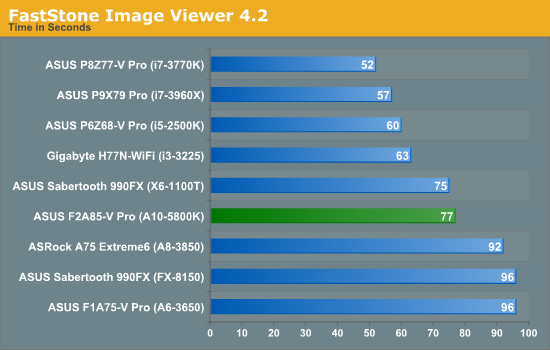
In the FastStone results, we see the Piledriver processor beat the Bulldozer and Stars cores by a considerable margin, and nudge the Thuban as well.
Xilisoft Video Converter
With XVC, users can convert any type of normal video to any compatible format for smartphones, tablets and other devices. By default, it uses all available threads on the system, and in the presence of appropriate graphics cards, can utilize CUDA for NVIDIA GPUs as well as AMD APP for AMD GPUs. For this test, we use a set of 32 HD videos, each lasting 30 seconds, and convert them from 1080p to an iPod H.264 video format using just the CPU. The time taken to convert these videos gives us our result.
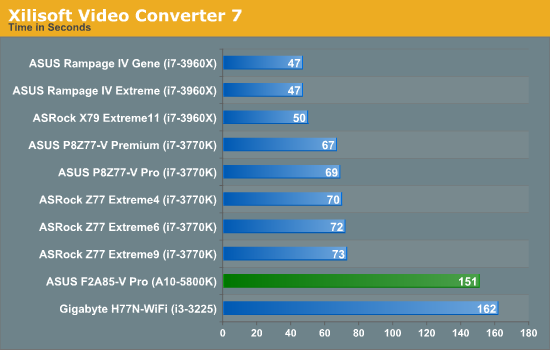
Unfortunately our Xilisoft benchmark is rather new, and thus we do not have results for all the AMD cores we have used in the past. However if we compare the A10-5800K directly with the i3-3225, we unfortunately have a memory difference to contend with (DDR3-2133 vs. DDR3-1600). With that being said, it is clear that video conversion is an INT process and all four of the A10-5800K INT units are being used.
x264 HD 4.0.1 Benchmark
The x264 HD Benchmark uses a common HD encoding tool to process an HD MPEG2 source at 1280x720 at 3963 Kbps. This test represents a standardized result which can be compared across other reviews, and is dependant on both CPU power and memory speed. The benchmark performs a 2-pass encode, and the results shown are the average of each pass performed four times.
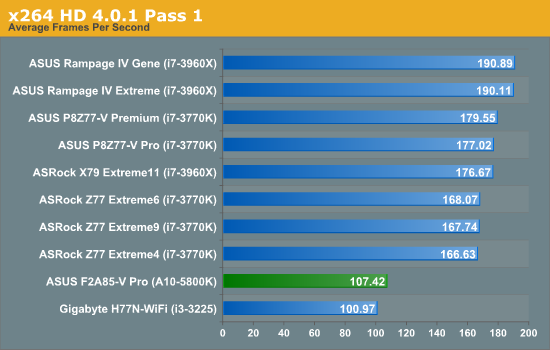
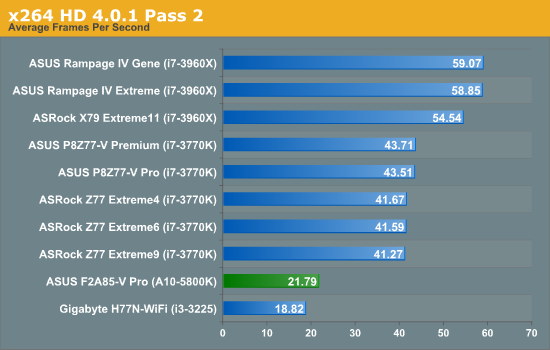










66 Comments
View All Comments
zappb - Sunday, November 4, 2012 - link
I just build 3 of these office machines (prices in euros before VAT / sales tax)AMD A6-5400K - 50
Asrock FM2A75M - DGS - 45
Fractal Core 1000 - 30
Intel 330 120 GB ssd - 75
Mushkin 4GB ddr3 -1600- 13
Be quiet pure power L7 300w - 32
Win8 pro oem (w/Start8)a 110
Office 2010 pro 100
Hardware comes to €245, and if I could have sourced the A4-5300, would have knocked another 15 off that. Amd will be pricing the entry level FM2 stuff really agressively in Jan 2013 onwards, so you could probably pick up the A4-5300 for 30 euro.
,
WEI scores are: Processor: 6.3, Memory: 5.9, Graphics: 4.7, Gaming Graphics: 6.3, primary hard disk, 8.1.
Will test power consumption shortly, but just seeing the load on the CPU with excel, word, and chrome with 5 browser windows open, it hovers around 1- 4%, so meaning for these light usage cases, it might be cheaper to run than the intel options (that would be a real turn up for the books).
crimson117 - Wednesday, October 10, 2012 - link
I'm having trouble parsing this sentence...> From my perspective, a storage system the RAID 5 that the A85X chipset supports across the eight SATA 6 Gbps ports is golden where Trinity is concerned.
KineticHummus - Thursday, October 11, 2012 - link
it means using trinity in a storage system/home server is great because it natively supports raid 5 across all 8 sata3 ports, which intel can not do.Anonymous Blowhard - Thursday, October 11, 2012 - link
Except that anyone running an 8-drive RAID5 with large, slow, consumer off the shelf SATA drives is either uninformed or a moron.Odds on getting an unrecoverable read error with large (1TB+) drives during a RAID5 rebuild are incredibly high; that's why enterprise SANs are using things like 450GB/600GB SAS drives now, and those have a failure rate an order of magnitude lower than consumer grade SATA.
Home servers should be using RAID1, 10, Z, Z2 - or just none at all. Whatever you use, doing proper backups (which RAID is not) is critical if you care about your data. DVDs I've ripped? I can get those again. Pictures of my son's first birthday? Backed up in triplicate, multiple offsite, and cloud stored.
http://www.zdnet.com/blog/storage/why-raid-5-stops...
ven1ger - Thursday, October 11, 2012 - link
First of if you're calling someone a moron, maybe you should look in the mirror.The article that you linked was written back in 2007, and if you read some of the comments, many of the comments thought it was much ado about nothing.
Maybe you should check out what current cloud based backup companies look like, here's an example that I was just reading about a couple of days ago.
http://blog.backblaze.com/
Very interesting story, commercial cloud based storage company that uses consumer SATA drives. They even have open-sourced hardware design(s) available for their PODs that anyone can use to create their own muti-drive backup system, and which several others have created, if you are so inclined that way.
I am no way involved with Backblaze, just was an interesting story piece that I ran across and their tale of harvesting consumer grade 3TB SATA drives in the aftermath of the Thailand flooding.
Anonymous Blowhard - Thursday, October 11, 2012 - link
Ad hominem ignored.The article was correct then and even more now. As data density has increased, reliability has not kept pace.
Using BackBlaze, or most any "cloud backup provider" as a reference for pro-RAID-5 is a bad idea. Cloud storage providers create their redundancy at the system level. Reliability, availability, and operational efficiencies are all hugely increased by treating the entire system as an FRU. It's cheaper for them to just wait for there to be enough downed pods to justify "Okay, let's roll into the DC, pull out a dozen systems, and slap in new ones." They don't have the time or concern to troubleshoot individual drive failures.
(Also, BackBlaze uses RAID-6.)
So again, if you're using RAID-5 with big, slow, error-prone drives; please stop doing that if you care about your data.
Memristor - Wednesday, October 10, 2012 - link
What version of the AHCI, RAID and USB 3.0 BIOS is on this new board? It would be very helpful if you could include the version of these BIOS's in your board reviews. Since it is very easy to updated the firmware of these components outside of a regular motherboard BIOS update it can be very helpful to increase performance and other issues that arise especially with RAID configurations and newer SSD drives.djshortsleeve - Wednesday, October 10, 2012 - link
Ian, glad you mentioned hysteresis. I dont understand why they dont incorporate this control? Its fairly simple as long as a target temperature is defined.goinginstyle - Wednesday, October 10, 2012 - link
"This could be an error on the part of OCCT.." If you do not know what the problem is then why mention it in the review as a performance concern. Either OCCT is updated to work with Trinity or more than likely it is not but find out before you state it. As to DPC latency, is it really a EFI problem or a platform problem as Llano is not much better.Hardcore69 - Wednesday, October 10, 2012 - link
Why bother? An Ivy Bridge i3 is 55w and is close to the equivalent except for the GPU, less than a fart's difference CPU wise. Compared to a hot 100w CPU, if you don't game, this isn't worth bothering with. At all for a standard office box. As for the mobo, I'd prefer a gruntier CPU than fancy useless heatpipes.